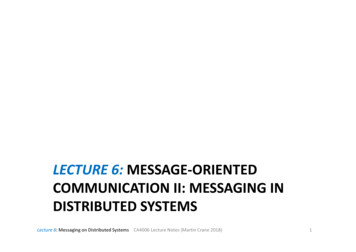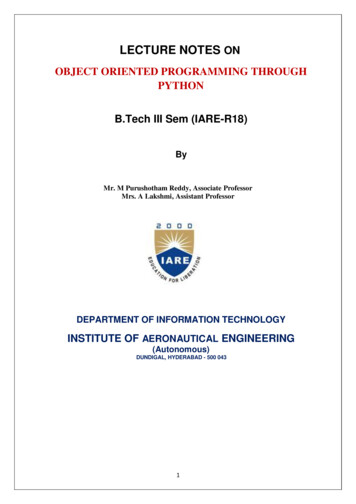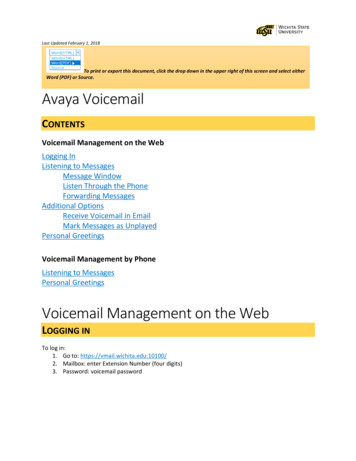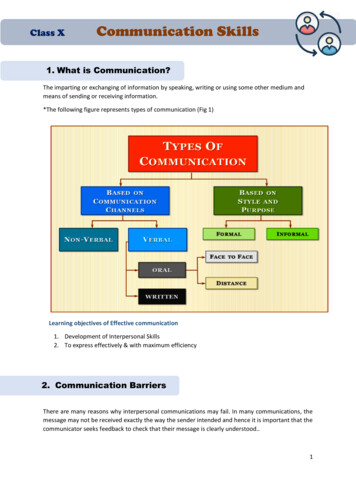
Transcription
LECTURE 6: MESSAGE-ORIENTEDCOMMUNICATION II: MESSAGING INDISTRIBUTED SYSTEMSLecture 6: Messaging on Distributed Systems CA4006 Lecture Notes (Martin Crane 2018)1
Lecture Contents Middleware in Distributed Systems Types of Distributed Communications– Remote Procedure Call (RPC): Parameter passing, Example: DCE Registration & Discovery in DCE– Message Queuing Systems: Basic Architecture, Role of Message Brokers– Example: IBM Websphere Advanced Message Queuing Protocol (AMQP)– Example: Rabbit MQ– Multicast Communications: Application Layer Messaging Epidemic ProtocolsLecture 6: Messaging on Distributed SystemsCA4006 Lecture Notes (Martin Crane 2018)2
SECTION 6.1: MIDDLEWARE INDISTRIBUTED SYSTEMSLecture 6: Messaging on Distributed Systems CA4006 Lecture Notes (Martin Crane 2018)3
Role of Middleware Observation– Role to provide common services/protocols in Distributed Systems– Can be used by many different distributed applications Middleware Functionality(Un)marshalling of data: necessary for integrated systemsNaming protocols: to allow easy sharing, discovery of resourcesSecurity protocols: for secure communicationScaling mechanisms, such as for replication & caching (e.g.decisions on where to cache etc.)– A rich set of comms protocols: to allow applications totransparently interact with other processes regardless of location.––––Lecture 6: Messaging on Distributed Systems CA4006 Lecture Notes (Martin Crane 2018)4
Classification of Middleware Classify middleware technologies into the following groups:1. Bog-standard Sockets The basis of all other middleware technologies.AppAppSocketTCPIPSocketTCPIPNetwork2. RPC – Remote Procedure Call (more later) RPCs provide a simple way to distribute application logic on separate e 6: Messaging on Distributed Systems CA4006 Lecture Notes (Martin Crane 2018)5
Classification of Middleware (/2)3. TPM - Transaction Processing Monitors: TPMs are a special form of MW targeted at distributed 4. DAM - Database Access Middleware: DBs can be used to share & communicate data between distributedapplications.ApplicationDriver ManagerODBC DriverApplicationDriver ManagerJDBC DriverNetworkDataSourceDataSourceDBDBLecture 6: Messaging on Distributed Systems CA4006 Lecture Notes (Martin Crane 2018)6
Classification of Middleware (/3)5. Distributed Tuple: Distributed tuple spaces implement a distributed shared memory space.Notify (Object)TransactionClientWrite (Object)JavaspacesServiceTake (Object)Write (Object)JavaspacesServiceClientRead (Object)6. DOT (Dist Object Technology) / OOM (Object-Oriented M/w): DOT extends the object-oriented paradigm to distributed bject BusObject ServicesLecture 6: Messaging on Distributed Systems CA4006 Lecture Notes (Martin Crane 2018)7
Classification of Middleware (/4)7. MOM (Message Oriented Middleware): In MOM, messages are exchanged asynchronously between distributedapplications (senders and receivers).SENDING SYSTEMSendingApplicationRECEIVING SYSTEMNon-blockingMessage SendNetworkReceivingApplication8. Web services: Web services expose services (functionality) on a defined interface,typically accessible through the web protocol HTTP.MiddlewareInternalServiceServiceClientWeb ServiceMiddlewareNetworkWeb ServiceInternalServiceLecture 6: Messaging on Distributed Systems CA4006 Lecture Notes (Martin Crane 2018)InternalServiceInternalService8
Classification of Middleware (/5)9. Peer-to-peer middleware: Have seen above how MW often follows particular architectural style.In P2P, each peer has equal role in comms pattern (eg routing, node mgmt)More on this later 10. Grid middleware: Provides computation power services (registration, allocation, deallocation) to mputationConsumerNetworkComputationConsumerLecture 6: Messaging on Distributed Systems CA4006 Lecture Notes (Martin Crane 2018)ComputationProviderComputationConsumer9
Summary of CommunicationsMiddleware Essentially a range of types of communications middleware All can be used to implement others, all are suited to different cases– All carry some payload from one side to another with details – Some of these payloads are ‘active’ and some are ‘passive’– Also differ in granularities and whether synchronous or not.Lecture 6: Messaging on Distributed Systems CA4006 Lecture Notes10(Martin Crane 2018)2017)10
SECTION 6.2: COMMUNICATION INDISTRIBUTED SYSTEMSLecture 6: Messaging on Distributed Systems CA4006 Lecture Notes (Martin Crane 2018)11
Terminology for DistributedCommunications Terminology for Distributed Communications– Persistent Communications: Once sent, the “sender” stops executing. “Receiver” need not be in operation – communications systembuffers message as required until delivery can occur.– Transient Communications: Message only stored as long as “sender” & “receiver” areexecuting. If problems occur either deal with them (sender is waiting) ormessage is simply discarded Lecture 6: Messaging on Distributed Systems CA4006 Lecture Notes (Martin Crane 2018)12
Persistence & Synchronicity in Communicationsa)b)Persistent asynchronous communicationPersistent synchronous communicationBufferingLecture 6: Messaging on Distributed Systems CA4006 Lecture Notes (Martin Crane 2018)13
Persistence & Synchronicity in Communications (/2)c)d)Transient asynchronous communicationReceipt-based transient synchronous communicationLecture 6: Messaging on Distributed Systems CA4006 Lecture Notes (Martin Crane 2018)14
Persistence & Synchronicity in Communications (/3)e)f)Delivery-based transient synchronous communication at messagedeliveryResponse-based transient synchronous communicationLecture 6: Messaging on Distributed Systems CA4006 Lecture Notes (Martin Crane 2018)15
SECTION 6.3: REMOTE PROCEDURECALL (RPC)Lecture 6: Messaging on Distributed Systems CA4006 Lecture Notes (Martin Crane 2018)16
Remote Procedure Call (RPC) Rationale: Why RPC? Distribution Transparency:– Send/Receive don’t conceal comms at all – need to achieve accesstransparency. Answer: Totally New ‘Communication’ System:– RPC allows programs to communicate by calling procedures on othermachines. Mechanism– When a process on machine A calls a procedure on machine B, callingprocess on A is suspended,– Execution of the called procedure takes place on B.– Info ‘sent’ from caller to callee in parameters & comes back in result.– No message passing at all is visible to the programmer.– Application developers familiar with simple procedure model.Lecture 6: Messaging on Distributed Systems CA4006 Lecture Notes (Martin Crane 2018)17
Basic RPC Operation6.7.8.9.Server works, returns result to stub.Stub builds message, calls local OS.OS sends message to client’s OS.Client OS gives message to client stub.1.2.3.4.Client procedure calls client stubStub builds message, calls local OS.OS sends message to remote OS.Remote OS gives message to stub.5.Stub unpacks parameters, calls server. 10. Stub unpacks result, returns to client.Lecture 6: Messaging on Distributed Systems CA4006 Lecture Notes (Martin Crane 2018)2015)1818
RPC: Parameter Passing Parameter marshallingMore than just wrapping parameters into a message:– Client/server machines may have different data representations(e.g. byte ordering)– Wrapping parameter means converting value into byte sequence– Client and server have to agree on the same encoding: How are basic data values represented (integers, floats, characters)? How are complex data values represented (arrays, unions)?– Client and server need to properly interpret messages,transforming them into machine-dependent representations.Lecture 6: Messaging on Distributed Systems CA4006 Lecture Notes (Martin Crane 2018)19
RPC: Parameter Passing (/2) Assumptions Regarding RPC Parameter Passing:– Copy in/copy out semantics: while procedure is executed, nothingcan be assumed about parameter values.– All data to be operated on is passed by parameters. Excludespassing references to (global) data. Conclusion– Full access transparency cannot be realized Observation:– A remote reference mechanism enhances access transparency:Remote reference offers unified access to remote data– Remote references can be passed as parameter in RPCsLecture 6: Messaging on Distributed Systems CA4006 Lecture Notes (Martin Crane 2018)20
RPC Example: Distributed ComputingEnvironment (DCE) Writing A Client and Server in DCE:Lecture 6: Messaging on Distributed Systems CA4006 Lecture Notes (Martin Crane 2018)21
DCE Client to Server Binding Registration & Discovery:– Server registration enables client to locate server and bind to it.– Server location is done in two steps:1. Locate the server’s machine.2. Locate the server on that machine.Lecture 6: Messaging on Distributed Systems CA4006 Lecture Notes (Martin Crane 2018)22
SECTION 6.4: MESSAGE QUEUINGSYSTEMSLecture 6: Messaging on Distributed Systems CA4006 Lecture Notes (Martin Crane 2018)23
Message-Oriented Persistent Comms Rationale: Why Another Messaging System?: Scalability:– “Transient” messaging systems, do not scale well geographically. Granularity:– MPI supports messaging O(ms). Distributed message transfer can take minutes What about RPC?:– In DS can’t assume receiver is “awake” default “synchronous, blocking”nature of RPC often too restrictive. How about Sockets, then?:– Wrong level of abstraction (only “send” and “receive”).– Too closely coupled to TCP/IP networks – not diverse enough Answer: Message Queueing Systems:– MQS give extensive support for Persistent Asynchronous Communication.– Offer medium-term storage for messages – don’t require sender/receiver to beactive during message transmission.Lecture 6: Messaging on Distributed Systems CA4006 Lecture Notes (Martin Crane 2018)24
Message-Oriented Persistent Comms. (/2) Message Queuing Systems:– Basic idea: applications communicate by putting messages into andtaking messages out of “message queues”.– Only guarantee: your message will eventually make it into the receiver’smessage queue “loosely-coupled” communications.– Asynchronous persistent communication thro middleware-level queues.– Queues correspond to buffers at communication servers. Four Commands:PrimitiveMeaningPutAppend a message to a specified queue.GetBlock until the specified queue is nonempty, and remove the first message.PollCheck a specified queue for messages, and remove the first. Never block.NotifyInstall a handler to be called when a message is put into the specified queue.Lecture 6: Messaging on Distributed Systems CA4006 Lecture Notes (Martin Crane 2018)25
Message-Queuing System Architecture Operation:– Messages are “put into” a source queue.– They are then “taken from” a destination queue.– Obviously, a mechanism has to exist to move a messagefrom a source queue to a destination queue.– This is the role of the Queue Manager. Function as message-queuing “relays” that interact withdistributed applications & each other. Not unlike routers, they support the idea of a DS “overlaynetwork”.Lecture 6: Messaging on Distributed Systems CA4006 Lecture Notes (Martin Crane 2018)26
Role of Message Brokers Rationale:Often need to integrate new/existing apps into a “single, coherentDistributed Information System (DIS)”. Problem: different message formats exist in legacy systemsCan’t “force” legacy systems into single, global message format.“Message Broker” allows us to live with different formatsCentralized component that takes care of application heterogeneityin an MQ system:– Transforms incoming messages to target format– Very often acts as an application gateway– May provide subject-based routing capabilities EnterpriseApplication IntegrationLecture 6: Messaging on Distributed Systems CA4006 Lecture Notes (Martin Crane 2018)27
Message Broker Organization General organization of message broker in a MQS – also knownvariously as an “interface engine”.2-30Queuing layer allows sourceClient to look up send queueFor destination clientLecture 6: Messaging on Distributed SystemsTo the source & Destinationclient Message Brokerjust looks like any other AppCA4006 Lecture Notes (Martin Crane 2018)28
IBM’s WebSphere MQ Basic concepts:– Application-specific messages are put into, removed from queues– Queues reside under the regime of a queue manager– Processes can put messages only in local queues, or thro an RPC Message transfer––––Messages are transferred between queuesMessage transfer btw process queues requires a channelAt each endpoint of channel is a message channel agentMessage channel agents are responsible for: Setting up channels using lower-level n/w comm facilities (e.g. TCP/IP) (Un)wrapping messages from/in transport-level packets Sending/receiving packetsLecture 6: Messaging on Distributed Systems CA4006 Lecture Notes (Martin Crane 2018)29
IBM’s WebSphere MQ (/2) Supported Topologies are:1. Hub/spoke topology (point-to-point queues): Apps subscribe to "their" QM. Routes to hub QM def’d in spoke QMs.2. Distributed Publish/Subscribe: Apps subscribe to topics & publish messages to multiple receivers. 2 Topologies: Clusters and Trees:Cluster: Cluster of QMs connected by channels. Published messagessent to all connected QMs of the published topic.Tree: Trees allow reducing number of channels between QMs.Lecture 6: Messaging on Distributed Systems CA4006 Lecture Notes (Martin Crane 2018)30
IBM’s WebSphere MQ (/2) Principles of Operation:––––Channels are inherently unidirectionalAutomatically start MCAs when messages arriveAny network of queue managers can be createdRoutes are set up manually (system administration)General organization of IBM's WebSphere Message-Queuing SystemLecture 6: Messaging on Distributed Systems CA4006 Lecture Notes (Martin Crane 2018)31
IBM’s WebSphere MQ (/3) Routing: Using logical names, in combination with name resolutionto local queues, possible to route message to remote queue– Sending message from one QM to another (possibly remote) QM, eachmessage needs destination address, so a transmission header is used– MQ Address has two parts:1. Part 1 is the Destination QM Name (say QMܺ)2. Part 2 is the Name of the Destination Queue (i.e. QMܺ’s destination Queue)– As each QM has unique name each QM knows each other by an AliasApp linked to QMA canRefer to a remote QMCusing local alias LA1Message TransferredTo QMB. Uses itstable to find QMCIn QMA’s routing tableLA1 should go to SQ1Lecture 6: Messaging on Distributed Systems CA4006 Lecture Notes (Martin Crane 2018)32
Advanced Message Queuing Protocol (AMQP) Why AMQP?1. Lack of standardization: Little standardization in MOM products (mostly proprietarysolutions).– E.g. 1: JMS Java- dependent, doesn’t specify wire protocol only an API. different JMS providers not directly interoperable on wire level.– E.g. 2: IBM Websphere clunky and expensive2. Need for bridges1 for interoperability: To achieve interoperability between different queueingsystems, 3rd party vendors offer bridges. These complicate the architecture / topology, increase costswhile reduce performance (additional delay).1Entitiesthat help in different stages of message mediationLecture 6: Messaging on Distributed Systems CA4006 Lecture Notes (Martin Crane 2018)33
AMQP (/2) Characteristics of AMPQ:– What is it? Open protocol for enterprise messaging, supported byindustry (JP Morgan, Cisco, Microsoft, Red Hat, Microsoft etc.).– Open/ Multi-platform / language messaging system.– AMQP defines:1. Messaging capabilities (called AMQP model)2. Wire-level protocol for interoperability– AMQP messaging patterns:1.2.3.Request-response: messages delivered to a specific queuePublish/Subscribe: messages delivered to a set of receiver queuesRound-robin: message distribution to set of receivers based on availability AMQP Model (simplified):Lecture 6: Messaging on Distributed Systems CA4006 Lecture Notes (Martin Crane 2018)34
ModelFan-outExchangeDirectExchangeAMQP Example:CA4006 Lecture Notes (Martin Crane 2018)35
#!/usr/bin/env ruby# encoding: utf-8require "bunny"conn Bunny.new(:automatically recover false)conn.startchqHello Worldin RabbitMQ conn.create channel ch.queue("hello") # create a message queue called “hello”ch.default exchange.publish("Hello World!", :routing key q.name)# default exchange is a direct exchange with no name# main advantage is every queue is automatically bound to it with routing key same as queue nameputs " [x] Sent 'Hello World!'"conn.close # close off the connection#!/usr/bin/env ruby# encoding: utf-8require "bunny"conn Bunny.new(:automatically recover false)conn.start # if conn fails, reconnect tried every 5 secs, this disables automatic connection recoverychqchannel.basic publish(exchange ‘ ‘, conn.create channelrouting key 'hello', ch.queue("hello") # create a message queue with same name as abovebody 'Hello World!')beginputs " [*] Waiting for messages. To exit press CTRL C"q.subscribe(:block true) do delivery info, properties, body puts " [x] Received #{body}"endrescue Interrupt # exception handling if Interrupt happens (i.e. if CTRL C hit)conn.close # close off the connectionLecture6: Messaging on Distributed Systems CA4006 Lecture Notes (Martin Crane 2018)exit(0)end36
RabbitMQ Afterwards should see something like this:Lecture 6: Messaging on Distributed Systems CA4006 Lecture Notes (Martin Crane 2018)37
Work Queue InLecture 6: Messaging on Distributed Systems CA4006 Lecture Notes (Martin Crane 2018)38
Work Queue In(/2) Afterwards should see something like this:Lecture 6: Messaging on Distributed Systems CA4006 Lecture Notes (Martin Crane 2018)39
Publish-Subscribe InLecture 6: Messaging on Distributed Systems CA4006 Lecture Notes (Martin Crane 2018)40
Topic-based RoutingPublish-Subscribe InLecture 6: Messaging on Distributed Systems CA4006 Lecture Notes (Martin Crane 2018)41
Fibonacci Server Using RPC InThe RPC will work this: On startup, client creates anonymous exclusive callback QFor RPC request, Client sends a message with 2 properties:reply to (set to the callback queue) & correlation id,(a unique value for each request)The request is sent to an rpc queue queue.RPC server awaits requests on that queue.– When a request comes, it does the job & returns a message withresult to Client, using the queue from the reply to field. Client awaits data on callback queue.– When one comes, it checks the correlation id property.– If it matches the request’s value it returns the response to theapplication.Lecture 6: Messaging on Distributed Systems CA4006 Lecture Notes (Martin Crane 2018)42
SECTION 6.5: MULTICASTCOMMUNICATIONLecture 6: Messaging on Distributed Systems CA4006 Lecture Notes (Martin Crane 2018)43
Multicast Communication Rationale: Often need to a Send-to-Many in Distributed Systems Examples:– Financial services: Delivery of news, stock quotes etc– E-learning: Streaming content to many students at different levels. Problem: IP Multicast is very efficient for bandwidth usage BUT key architectural decision: Add support for multicast in IP layerand no wide area IP multicast support Solutions:1. Application-Level Multicasting– Nodes organize (e.g. with chord to build, maintain) into an overlay n/w,– Can then disseminate information to members2. Gossip-based data dissemination– Rely on epidemic behaviour for data spreadingLecture 6: Messaging on Distributed Systems CA4006 Lecture Notes (Martin Crane 2018)44
1. Application-Level Multicasting (ALM) Basics: In ALM, message sent over multicast tree created on overlay network– Sender is the root of the tree which spans all the receivers A connection between two nodes may cross several physical links ALM may incur more cost than network-level multicast (i.e. crosssame physical link more than once)Multicast on Chord Network11fromTalia & Trunfrio, J. Parallel & Dist Computing Vol(70(12)) pp1254 - 1265, 2010Lecture 6: Messaging on Distributed Systems CA4006 Lecture Notes (Martin Crane 2018)45
2. Epidemic Algorithms Essence: Epidemic algorithms used to rapidly spread info in large P2Psystems without setting up a multicast tree Assumptions:– All updates for specific data item are done at a single node (i.e., nowrite-write conflict)– Can distinguish old from new data as data is time stamped or versioned Operation:– Node receives an update, forwards it to randomly chosen peers (akin tospreading a contagious disease)– Eventually, each update should reach every node– Update propagation is lazyLecture 6: Messaging on Distributed Systems CA4006 Lecture Notes (Martin Crane 2018)46
2. Epidemic Algorithms (/2) Glossary of Terms:– Node is infected if it has an update & wants to send to others– Node is susceptible if it has not yet been updated/infected– Node is removed if it is not willing or able to spread its update orcan no longer send to others for some reason. We study two propagation models here:– Anti-entropyEach replica regularly chooses another randomly & exchanges statedifferences, giving identical states at both afterwards.– Gossiping:A replica which has just been updated (i.e., has been infected), tellsother replicas about its update (infecting them as well).Lecture 6: Messaging in Distributed SystemsCA4006 Lecture Notes (Martin Crane 2018)47
2. Epidemic Algorithms (/3) Principal Operations of Anti-Entropy:– A node selects another node from the system at random. Push: only sends its updates to Pull: only retrieves updates from Push-Pull: and exchange mutual updates (after which theyhold the same information). Observations– For push-pull it takes (log( )) rounds to disseminate updates toall nodes (round when every node has initiated an exchange).– Anti-Entropy is reliable but costly (each replica must regularlychoose another randomly)Lecture 6: Messaging in Distributed SystemsCA4006 Lecture Notes (Martin Crane 2018)48
2. Epidemic Algorithms (/4) Basic model of Gossiping:– A server S having an update to report, contacts other servers.– If a server is contacted to which update has already propagated, S stopscontacting other servers with probability ଵ .– i.e. increasing ensures almost total ‘gossip’ propagation Observations– If is fraction of servers unawareof update, can show that withmany servers, the equation ି ାଵ ଵି௦is satisfied– Example: for 10,000 servers:when 4, 0.007– If need 100% propagation, gossiping alone is not enough, maybe needto run one round of anti-entropy.Lecture 6: Messaging in Distributed SystemsCA4006 Lecture Notes (Martin Crane 2018)49
2. Epidemic Algorithms (/5) The Deletion Problem in Epidemic Algorithms:– Cannot remove old value from a server, expecting removal to propagate.– Instead, mere removal will be undone in time using epidemic algorithms Solution: Must register removal as special update by inserting a death cert Next problem:– When to remove a death certificate (it is not allowed to stay for ever)? Run a global algorithm to detect if removal is known everywhere, and thencollect the death certificates (looks like garbage collection) orAssume death certificates propagate in finite time, and associate maxlifetime for a certificate (can be done at risk of not reaching all servers)– Note: It is necessary that a removal actually reaches all servers. Applications of Epidemic Algorithms:– (Obviously) data dissemination– Data aggregation: each node with value ݔ . Two nodes gossiping should resettheir variable to ( ݔ ݔ )/2. What final value will nodes possess?Lecture 6: Messaging in Distributed SystemsCA4006 Lecture Notes (Martin Crane 2018)50
Lecture Summary Middleware enables much functionality in DS Especially the many types of interaction/communicationsnecessary With rational reasons for every one!– Remote Procedure Call (RPC) enables transparency– But Message Queuing Systems necessary for persistentcommunications IBM Websphere is ok but a bit old, clunky & tired at this stage? AMQP open source, more flexible, better Industrial support?– Multicast Communications are often necessary in DS: Application Layer Messaging (ALM) Epidemic ProtocolsLecture 6: Messaging in Distributed SystemsCA4006 Lecture Notes (Martin Crane 2018)51
Service DB Service DB Transaction Processing Monitor Network Client . Object Bus Lecture 6 : Messaging on Distributed Systems CA4006 Lecture Notes (Martin Crane 2018) 7. . - May provide subject-based routing capabilities Enterprise Application Integration Lecture 6 : Messaging on Distributed Systems CA4006 Lecture Notes (Martin Crane .










